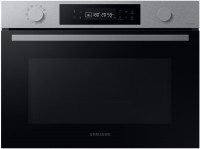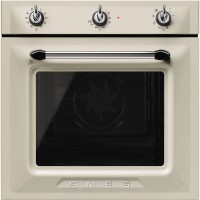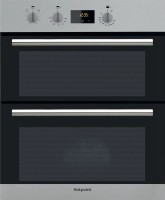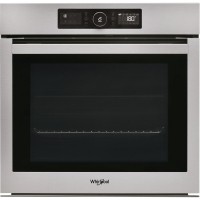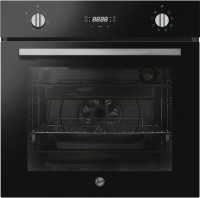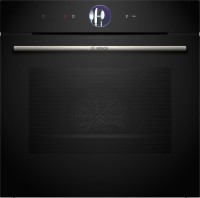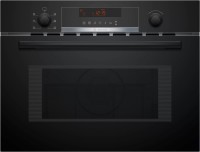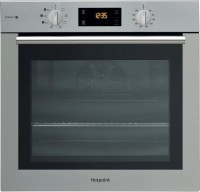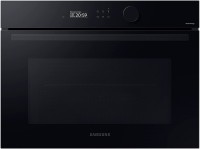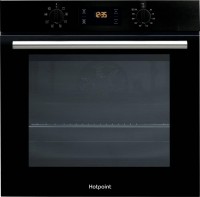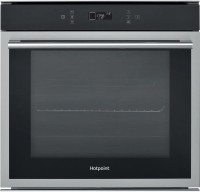Ovens Smeg
All Ovens Advanced filters → |
You might be interested in
Articles, reviews, useful tips
All materials
TOP 5 large and functional ovens
Ovens for large families and those who bake a lot

Pyrolysis, catalysis, hydrolysis: what is the most effective method of cleaning an oven?
Let's figure out what catalytic, pyrolytic and hydrolytic oven cleaning are and what are their advantages

TOP 5 affordable ovens from trusted brands
Full-size ovens from reputable manufacturers with reasonable prices

Bosch oven markings
In this article, we will focus on deciphering the "names" of Bosch ovens

What is Sous vide technology (sous vide) and is it needed in the home kitchen
Cooking homemade dishes "under vacuum" will expand the family menu and pleasantly surprise your guests

TOP 5 ovens with microwave
Compact built-in ovens that support microwave function
Ovens: specifications, types
Type
— Electric. Ovens with electric heating elements. Such models are much easier and safer to install and connect than gas ones. They can be used even in the absence of gas supply (for example, in private houses not connected to a gas pipeline, high-rise buildings where gas is not supplied for security reasons, etc.). In addition, it is easier to implement specific cooking modes and other additional functions in an electric oven, and heating in such models is more even. On the other hand, the power consumption of electric ovens is quite high, which means that they cannot be operated from conventional sockets, require reliable wiring, and can significantly affect your electricity bills.
— Gas. Ovens with heaters in the form of gas burners. The operation of such models, usually, is cheaper than electric ones. In addition, they heat up faster. However, the heating is less uniform. Such devices can only be installed where gas is supplied (or use replaceable gas cylinders, which is not very convenient). And installation should be carried out by gas specialists.
— Gas. Ovens with heaters in the form of gas burners. The operation of such models, usually, is cheaper than electric ones. In addition, they heat up faster. However, the heating is less uniform. Such devices can only be installed where gas is supplied (or use replaceable gas cylinders, which is not very convenient). And installation should be carried out by gas specialists.
Design
Ovens designed for installation in kitchens with a retro design. They have a specific vintage design, allowing them to fit into the appropriate interior. In terms of functionality, they do not have fundamental differences from classic ovens. However, controls based on rotary knobs and mechanical timers are most often used. At the same time, retro ovens, usually, are not cheap, since they are created mainly as designer models.
Controls
The type of control panel installed in the oven. To date, there are such options:
— Rotary knobsswitches. Controls based on classic rotary knobs, known to many users for other types of kitchen appliances — primarily classic cookers. This type of control can be found in both low-cost and advanced models: the specifics of the operation of ovens are such that many functions (both basic and additional) are conveniently controlled with rotary knobs and the simplest mechanical controls, and a complex electronic circuits. However, rotary knobs in their pure form are not used very often today — much more often they are combined with buttons or touch controls (see below).
— Push-buttons. Push-button controls are typical of the electronic type and use complex control circuits, making this type of control suitable for models with a wide range of additional features. However, pure push-button controls, without rotary knobs, are very rare in ovens. On the one hand, for some functions, such controls are less convenient than rotary knobs; on the other hand, they are rather unusual for ovens, which can cause additional discomfort for the user.
— Touch controls. They are in many ways similar to push-buttons (see above). The main difference between touch controls and buttons is that the touch controls respond to touch, not to press. Thanks to this, using such pane...ls is much easier. In addition, the touch sensors give the device a stylish look and are easy to clean because they do not have protruding parts. Such controls in their pure form, not combined with rotary knobs, are also quite rare. However, for several reasons, there are still much more touch controls models than push-button ones.
— Rotary knobs with push-buttons. Control panels equipped with both rotary knobs and buttons. See above for more details on both. Here we note that the combination of two types of control allows not only to combine their advantages but also provides additional convenience: some functions of the oven can be tied to rotary knobs, others to buttons, linking each function with the type of control that is optimal for it. Due to this, this option is the most common today.
— Rotary knobs with touch controls. Combined control with rotary knobs and touch controls (see above for more on both). Like the “rotary knobs with push-buttons” option (also described above), it is very convenient because each function of the oven is tied to the type of control that is optimal for it — either to the rotary knob or to the touch controls. This option is much less common, but this is not due to inconvenience but primarily to the high cost of touch controls compared to push-buttons. Accordingly, it is used mainly in models of the middle and top classes.
— Pop out knobs. A variation of the rotary knobs described above, in which the knobs can be recessed into the control panel. Usually, pop out knobs are designed to stay outside only during the direct setting of the operating mode, and for the time when the oven is not in use or works in one mode, they can be hidden. It gives the unit a neat appearance, reduces the places where dirt can accumulate and makes the front panel easier to clean. Unlike rotary knobs, pop out knobs are mainly used in electrical models.
— Pop out knobs with push-buttons. Controls combining Pop out knobs with push-buttons. Both of these types of controls are described above, and in itself, this option is almost the same as a combination of buttons with rotary knobs (also see above).
— Pop out knobs with touch controls. A variant, by the name, combines pop out knobs and touch controls. Each of these types of control is described separately above, and their combination is almost no different from the combination of rotary knobs with touch controls (also see above). Except with the correction that recessed knobs keep the number of protruding elements on the control panel to an absolute minimum.
— Rotary knobsswitches. Controls based on classic rotary knobs, known to many users for other types of kitchen appliances — primarily classic cookers. This type of control can be found in both low-cost and advanced models: the specifics of the operation of ovens are such that many functions (both basic and additional) are conveniently controlled with rotary knobs and the simplest mechanical controls, and a complex electronic circuits. However, rotary knobs in their pure form are not used very often today — much more often they are combined with buttons or touch controls (see below).
— Push-buttons. Push-button controls are typical of the electronic type and use complex control circuits, making this type of control suitable for models with a wide range of additional features. However, pure push-button controls, without rotary knobs, are very rare in ovens. On the one hand, for some functions, such controls are less convenient than rotary knobs; on the other hand, they are rather unusual for ovens, which can cause additional discomfort for the user.
— Touch controls. They are in many ways similar to push-buttons (see above). The main difference between touch controls and buttons is that the touch controls respond to touch, not to press. Thanks to this, using such pane...ls is much easier. In addition, the touch sensors give the device a stylish look and are easy to clean because they do not have protruding parts. Such controls in their pure form, not combined with rotary knobs, are also quite rare. However, for several reasons, there are still much more touch controls models than push-button ones.
— Rotary knobs with push-buttons. Control panels equipped with both rotary knobs and buttons. See above for more details on both. Here we note that the combination of two types of control allows not only to combine their advantages but also provides additional convenience: some functions of the oven can be tied to rotary knobs, others to buttons, linking each function with the type of control that is optimal for it. Due to this, this option is the most common today.
— Rotary knobs with touch controls. Combined control with rotary knobs and touch controls (see above for more on both). Like the “rotary knobs with push-buttons” option (also described above), it is very convenient because each function of the oven is tied to the type of control that is optimal for it — either to the rotary knob or to the touch controls. This option is much less common, but this is not due to inconvenience but primarily to the high cost of touch controls compared to push-buttons. Accordingly, it is used mainly in models of the middle and top classes.
— Pop out knobs. A variation of the rotary knobs described above, in which the knobs can be recessed into the control panel. Usually, pop out knobs are designed to stay outside only during the direct setting of the operating mode, and for the time when the oven is not in use or works in one mode, they can be hidden. It gives the unit a neat appearance, reduces the places where dirt can accumulate and makes the front panel easier to clean. Unlike rotary knobs, pop out knobs are mainly used in electrical models.
— Pop out knobs with push-buttons. Controls combining Pop out knobs with push-buttons. Both of these types of controls are described above, and in itself, this option is almost the same as a combination of buttons with rotary knobs (also see above).
— Pop out knobs with touch controls. A variant, by the name, combines pop out knobs and touch controls. Each of these types of control is described separately above, and their combination is almost no different from the combination of rotary knobs with touch controls (also see above). Except with the correction that recessed knobs keep the number of protruding elements on the control panel to an absolute minimum.
Capacity
The working capacity of the oven. The amount of food that can be cooked in the device and the amount of space required for embedding depends on this parameter.
A capacity of about 50 – 60 litres is considered quite sufficient for a family of 2 – 3 people. It is the capacity that most modern built-in ovens have. However, there are other options — modest models of 20 – 30 litres, similar in capacity to microwave ovens, large in capacity for home baking and large cabinets of 100 litres or more, designed more for cafes and restaurants than for home use.
A capacity of about 50 – 60 litres is considered quite sufficient for a family of 2 – 3 people. It is the capacity that most modern built-in ovens have. However, there are other options — modest models of 20 – 30 litres, similar in capacity to microwave ovens, large in capacity for home baking and large cabinets of 100 litres or more, designed more for cafes and restaurants than for home use.
Cooking temperature
The cooking temperature range allows you to understand which special tasks are subject to the oven. The lower temperature from which the oven starts heating, usually, is in the range of +30 to +50 ˚C. So, for example, the minimum heating temperature at +30 ˚C allows you to defrost products. Models with a minimum of 40 ˚C and 50 ˚C allow you to heat ready meals, heat tableware (before serving), dry crackers, etc.
Cooking modes
Among the cooking modes, one can single out modes that are relevant for models in the role of ovens (these are grill, convection, convection with heater, double convection, rotisserie fork, temperature probe), as well as special operating modes that turn the oven into another device on the kitchen table ( microwave oven, built-in steamer and steam cooking)
— Microwave. The presence of a microwave heater in the oven, along with an electric or gas one (see "Oven"). This feature significantly expands the functionality of the device: a microwave generator is convenient for heating and defrosting food, and its use in combination with the main heater allows you to speed up the cooking time and provide better heating, especially when cooking the product as a whole piece (for example, when baking boiled pork). At the same time, such combined ovens are more expensive than conventional ones not equipped with a microwave.
— Built-in steamer. Possibility of using the oven for steam cooking. Cooking is carried out in the main chamber of the oven, and the steam comes from a special reservoir into which water is poured in advance. This method is con...sidered more healthy than traditional cooking or frying. In addition, it often turns out to be optimal for people with dietary restrictions. However, models with steamer functions are also more expensive than usual ones.
— Steam cooking. Water is poured into a special tray at the bottom of the oven, and evaporates under the influence of high temperature, thereby steaming the dishes in the device. However, such ovens have basic capabilities and do not have a separate programme, modes, or sensors that would monitor the work and the steam cooking process itself.
— Grill. Device for cooking food using thermal radiation. The grill allows you to get dishes with a fried surface or crispy crust. However, this method of cooking is considered healthier than frying in oil. This function is especially useful in combination with a rotisserie fork (see below).
— Convection. This function implies the presence of a fan in the oven, which forcibly draws heated air through the working chamber. It ensures a more even distribution of heat than with natural (without a fan) air circulation, which has a positive effect on the heating efficiency and the quality of cooking.
– Convection with heater. The combination of convection for uniform distribution of heated air flows and an annular heater, which is located around the fan. In this cooking mode, an increase in the temperature of the air driven by the blades is ensured. This type of dry convection is more efficient as it allows the circulating air to warm up evenly faster.
— Double convection. Improved convection function (see above), in which two fans are responsible for air circulation at once. According to the manufacturers, this ensures the evenest distribution of hot air throughout the volume of the oven and, accordingly, high-quality cooking. In addition, double convection is found in models with an additional chamber — where each fan is responsible for its own oven compartment.
— Rotisserie fork. A device in the form of a fork on which pieces of meat, chicken or other food can be strung. When cooking, this fork rotates, which allows you to evenly heat the dish from all sides. In modern ovens, this function is necessarily combined with a grill (see above); other cooking methods for a rotisserie fork are of little use or do not make sense.
— Temperature probe. A device for measuring the temperature of cooked food. It looks like a thin rod with a temperature sensor at the end. With such a rod, you can measure the temperature both outside and inside the dish being prepared, determining its condition and degree of readiness. Temperature probes are especially useful when roasting meat.
— Double oven. The ability to cook two different dishes at the same time in the oven saves time — for example, you can bake meat in the upper chamber and cook cake layers in the lower one. And the role of a partition between the chambers is played by a baking sheet, which can be removed and the oven used for a total volume.
— Custom programme. Ability to create your own oven programme. Such programmes are similar to automatic ones (for more details, see “Number of automatic programmes”). However, unlike the latter, you can change them at your own discretion and save them in the oven’s memory, which gives you ample features to customize the oven to your preferences. — Defrosting. A programme for gentle defrosting of frozen foods. In this mode, the oven operates at a low intensity — so that the contents effectively thawed but, at the same time, did not bake. Data on the defrosting time required for a certain amount of a certain product is usually given in the instructions for use.
— Microwave. The presence of a microwave heater in the oven, along with an electric or gas one (see "Oven"). This feature significantly expands the functionality of the device: a microwave generator is convenient for heating and defrosting food, and its use in combination with the main heater allows you to speed up the cooking time and provide better heating, especially when cooking the product as a whole piece (for example, when baking boiled pork). At the same time, such combined ovens are more expensive than conventional ones not equipped with a microwave.
— Built-in steamer. Possibility of using the oven for steam cooking. Cooking is carried out in the main chamber of the oven, and the steam comes from a special reservoir into which water is poured in advance. This method is con...sidered more healthy than traditional cooking or frying. In addition, it often turns out to be optimal for people with dietary restrictions. However, models with steamer functions are also more expensive than usual ones.
— Steam cooking. Water is poured into a special tray at the bottom of the oven, and evaporates under the influence of high temperature, thereby steaming the dishes in the device. However, such ovens have basic capabilities and do not have a separate programme, modes, or sensors that would monitor the work and the steam cooking process itself.
— Grill. Device for cooking food using thermal radiation. The grill allows you to get dishes with a fried surface or crispy crust. However, this method of cooking is considered healthier than frying in oil. This function is especially useful in combination with a rotisserie fork (see below).
— Convection. This function implies the presence of a fan in the oven, which forcibly draws heated air through the working chamber. It ensures a more even distribution of heat than with natural (without a fan) air circulation, which has a positive effect on the heating efficiency and the quality of cooking.
– Convection with heater. The combination of convection for uniform distribution of heated air flows and an annular heater, which is located around the fan. In this cooking mode, an increase in the temperature of the air driven by the blades is ensured. This type of dry convection is more efficient as it allows the circulating air to warm up evenly faster.
— Double convection. Improved convection function (see above), in which two fans are responsible for air circulation at once. According to the manufacturers, this ensures the evenest distribution of hot air throughout the volume of the oven and, accordingly, high-quality cooking. In addition, double convection is found in models with an additional chamber — where each fan is responsible for its own oven compartment.
— Rotisserie fork. A device in the form of a fork on which pieces of meat, chicken or other food can be strung. When cooking, this fork rotates, which allows you to evenly heat the dish from all sides. In modern ovens, this function is necessarily combined with a grill (see above); other cooking methods for a rotisserie fork are of little use or do not make sense.
— Temperature probe. A device for measuring the temperature of cooked food. It looks like a thin rod with a temperature sensor at the end. With such a rod, you can measure the temperature both outside and inside the dish being prepared, determining its condition and degree of readiness. Temperature probes are especially useful when roasting meat.
— Double oven. The ability to cook two different dishes at the same time in the oven saves time — for example, you can bake meat in the upper chamber and cook cake layers in the lower one. And the role of a partition between the chambers is played by a baking sheet, which can be removed and the oven used for a total volume.
— Custom programme. Ability to create your own oven programme. Such programmes are similar to automatic ones (for more details, see “Number of automatic programmes”). However, unlike the latter, you can change them at your own discretion and save them in the oven’s memory, which gives you ample features to customize the oven to your preferences. — Defrosting. A programme for gentle defrosting of frozen foods. In this mode, the oven operates at a low intensity — so that the contents effectively thawed but, at the same time, did not bake. Data on the defrosting time required for a certain amount of a certain product is usually given in the instructions for use.
Number of modes
The number of cooking modes provided in the design of the oven. In this case, the cooking mode means the general opertaion mode — for example, “heating”, “heating + convection”, etc. Accordingly, this indicator strongly depends on additional equipment (see "Features"). However, even in similar models, the number of modes may be different. In general, the more cooking modes, the more cooking options, the easier it will be to choose the optimal mode for a specific situation.
Number of automatic programmes
The number of preinstalled cooking programmes stored in the oven's memory — usually designed for a specific dish or just a defrost mode. If you have the appropriate programme, you do not have to keep track of the time, manually change the temperature and rearrange the dish in the oven — just put the ingredients there and start the programme, and the device will do the rest on its own. At the same time, unlike individual cooking modes (see above), the programmes are more complex — they provide changing temperatures, turning on special modes, turning off when time has elapsed, etc. The larger the set of automatic programmes, the wider the possibilities of the oven; their number in modern models can be in the tens. On the other hand, such programmes cannot be changed at will, so if you need both creativity and maximum convenience, you should pay attention to models with the ability to record custom programme in memory.
Features
Among the ovens features, one can single out the basic ones inherent in most devices ( gas control, auto ignition, thermostat, timer, auto switch-off, child lock), and top-level features that are relevant for devices of the highest category ( control via Internet, built-in video camera, TFT display). More about them:
— Gas control. Thermoelectric system designed to protect against gas leakage. If the flame is accidentally extinguished, the gas supply to the chamber is immediately stopped. The gas control usually includes a thermocouple (to determine the presence or absence of a flame) and a gas blocking device.
— Auto ignition. A system that provides automatic ignition of gas simultaneously with the start of its supply. The user does not need to use matches or a lighter, press a separate button, etc.: the gas ignites immediately when the handle is turned. Found only in models with appropriate heaters (see "Oven").
— Thermostat. A device that maintains a predetermined temperature in the oven.
— Timer. A device that provides a countdown time and allows you to control the cooking process precisely. After the set time has elapsed, the timer, usually, beeps, and in some models, i...t also turns off the heating. Timers can be either mechanical or electronic; the first one is simple and inexpensive, and the second one is more accurate and better combined with additional features (for example, auto switch-off).
— Auto switch-off. In this case, we are talking about a function that provides automatic shutdown of the oven according to the timer (see below); the timer itself does not imply auto-off, so if such an ability is important, you should choose a model where it is directly stated. Also, auto switch-off can be provided as a protective system that prevents overheating — such automation turns off the oven if no commands have been received from the user for a long time or when the temperature rises critically.
— Control via Internet. The specific control method may be different: some models use an application that needs to be installed on a smartphone or tablet, while others use a regular web page that can be opened in any browser. These details should be specified separately. Anyway, this function allows you to access control from anywhere in the world where there is access to the World Wide Web. For example, in the morning you can load food for a dish into the oven, and when you leave work, launch a cooking programme via the Internet, and get a ready-made hot dish by the time you return home. Also, note that such control usually allows not only to give commands but also to receive notifications from the oven. In particular, the device can report the progress of the programme, readiness, various problems, etc.
— Video camera. The presence of a built-in camera for more detailed control of the preparation of the dish. The user can visually control the cooking process without opening the oven door. Most often, the built-in camera transmits video via a wireless Wi-Fi connection. As a pairing device, you can use both a computer with a laptop and a tablet/smartphone. Of course, on a mobile/computer device, you will need to install proprietary software. The video camera is especially relevant in cases where the oven is used to prepare complicated meals. Regular control, without disturbing the temperature regime due to the opening of the door, minimizes the risk of food spoilage.
— TFT display. The oven has its TFT display. In this case, we mean a screen that does not consist of segments but pixels and is suitable for displaying various types of data: numbers, text, graphic symbols, pictures, etc. A wide variety of information can be displayed on the TFT display, which makes the operation of the oven more convenient. However, this variety is only relevant for advanced models with an abundance of functions, so the presence of such a screen is usually a sign of a premium oven.
— Child lock. In modern ovens, it can be done in different ways. So, in some models, you can block the oven door — so that a curious little child cannot open it during cooking and get burned. In other devices, a control panel lock is also provided — thanks to it, the baby will not be able to turn on/off the device or change the cooking mode. Child lock is unlocked in a non-obvious way accessible to an adult but not to a child — for example, by simultaneously pressing two buttons.
— Gas control. Thermoelectric system designed to protect against gas leakage. If the flame is accidentally extinguished, the gas supply to the chamber is immediately stopped. The gas control usually includes a thermocouple (to determine the presence or absence of a flame) and a gas blocking device.
— Auto ignition. A system that provides automatic ignition of gas simultaneously with the start of its supply. The user does not need to use matches or a lighter, press a separate button, etc.: the gas ignites immediately when the handle is turned. Found only in models with appropriate heaters (see "Oven").
— Thermostat. A device that maintains a predetermined temperature in the oven.
— Timer. A device that provides a countdown time and allows you to control the cooking process precisely. After the set time has elapsed, the timer, usually, beeps, and in some models, i...t also turns off the heating. Timers can be either mechanical or electronic; the first one is simple and inexpensive, and the second one is more accurate and better combined with additional features (for example, auto switch-off).
— Auto switch-off. In this case, we are talking about a function that provides automatic shutdown of the oven according to the timer (see below); the timer itself does not imply auto-off, so if such an ability is important, you should choose a model where it is directly stated. Also, auto switch-off can be provided as a protective system that prevents overheating — such automation turns off the oven if no commands have been received from the user for a long time or when the temperature rises critically.
— Control via Internet. The specific control method may be different: some models use an application that needs to be installed on a smartphone or tablet, while others use a regular web page that can be opened in any browser. These details should be specified separately. Anyway, this function allows you to access control from anywhere in the world where there is access to the World Wide Web. For example, in the morning you can load food for a dish into the oven, and when you leave work, launch a cooking programme via the Internet, and get a ready-made hot dish by the time you return home. Also, note that such control usually allows not only to give commands but also to receive notifications from the oven. In particular, the device can report the progress of the programme, readiness, various problems, etc.
— Video camera. The presence of a built-in camera for more detailed control of the preparation of the dish. The user can visually control the cooking process without opening the oven door. Most often, the built-in camera transmits video via a wireless Wi-Fi connection. As a pairing device, you can use both a computer with a laptop and a tablet/smartphone. Of course, on a mobile/computer device, you will need to install proprietary software. The video camera is especially relevant in cases where the oven is used to prepare complicated meals. Regular control, without disturbing the temperature regime due to the opening of the door, minimizes the risk of food spoilage.
— TFT display. The oven has its TFT display. In this case, we mean a screen that does not consist of segments but pixels and is suitable for displaying various types of data: numbers, text, graphic symbols, pictures, etc. A wide variety of information can be displayed on the TFT display, which makes the operation of the oven more convenient. However, this variety is only relevant for advanced models with an abundance of functions, so the presence of such a screen is usually a sign of a premium oven.
— Child lock. In modern ovens, it can be done in different ways. So, in some models, you can block the oven door — so that a curious little child cannot open it during cooking and get burned. In other devices, a control panel lock is also provided — thanks to it, the baby will not be able to turn on/off the device or change the cooking mode. Child lock is unlocked in a non-obvious way accessible to an adult but not to a child — for example, by simultaneously pressing two buttons.
Door opening
The method of opening the door provided in the design of the oven.
— Right. The rotary axis in such doors is on the right side, respectively, and the door turns to the right when opened. In some cases, this option is more convenient than the classic downwards opening.
— Left. Another version of the side opening, completely similar to the right opening (see above), but with the door turning to the left. It occurs somewhat more often, as it allows you to open the oven with your left hand, leaving your right hand free (for example, to remove a baking sheet or work with a temperature probe).
— Retractable trolley. A door that slides forward when opened while remaining in an upright position. Such doors are often combined with guides — in such a way that the trays leave the oven immediately when the door is opened. It makes it easier to remove them. However, in some situations, the automatic pull-out of the trays is undesirable. This type of door is expensive.
— Lift system. The original design, according to the principle of operation, actually resembles an elevator. The door in such ovens is not located in the front but on top, and when opened, it slides up, pulling out a frame with guides for baking sheets. Ovens with lift systems not only look unusual but also provide easy access to baking sheets. However..., they are quite expensive, and it is impossible to put a hob over such an oven.
Most models have a classic way of downwards opening : when opened, the door leans forward. This option is convenient because it allows you to look inside (at least see the upper baking sheet) without opening the door completely and without releasing excess heat from the working chamber.
— Right. The rotary axis in such doors is on the right side, respectively, and the door turns to the right when opened. In some cases, this option is more convenient than the classic downwards opening.
— Left. Another version of the side opening, completely similar to the right opening (see above), but with the door turning to the left. It occurs somewhat more often, as it allows you to open the oven with your left hand, leaving your right hand free (for example, to remove a baking sheet or work with a temperature probe).
— Retractable trolley. A door that slides forward when opened while remaining in an upright position. Such doors are often combined with guides — in such a way that the trays leave the oven immediately when the door is opened. It makes it easier to remove them. However, in some situations, the automatic pull-out of the trays is undesirable. This type of door is expensive.
— Lift system. The original design, according to the principle of operation, actually resembles an elevator. The door in such ovens is not located in the front but on top, and when opened, it slides up, pulling out a frame with guides for baking sheets. Ovens with lift systems not only look unusual but also provide easy access to baking sheets. However..., they are quite expensive, and it is impossible to put a hob over such an oven.
Most models have a classic way of downwards opening : when opened, the door leans forward. This option is convenient because it allows you to look inside (at least see the upper baking sheet) without opening the door completely and without releasing excess heat from the working chamber.
Door opening
— Button door opening. The touch button assumes electronic control of the door lock. The main advantage of touch buttons is the absence of rubbing pairs — the sensor is more reliable than a mechanical button. Touch control ovens belong to the advanced category.
Number of door glasses
The number of layers of glass in the viewing window of the oven door.
Modern models, usually, have from 2 to 4 glasses. The more glasses, the less heat loss and the more economical the oven, but this parameter also affects the cost.
Modern models, usually, have from 2 to 4 glasses. The more glasses, the less heat loss and the more economical the oven, but this parameter also affects the cost.
Door closer
The presence of an automatic door closer in the design of the oven.
Such a device is responsible for pulling the door when closing, and in some models, when opening. The idea is that the user does not need to close/open the door completely — just pull it to the right place, and then the door will be smoothly brought to a fully open or closed state by the door closer. Such a system performs two functions. Firstly, it reduces to almost zero the risk of leaving the oven not completely closed (which is fraught with various unpleasant situations): the auto-closer is usually able to attract even a fairly wide open door. Secondly, such a device provides a very smooth opening and closing, without shock, which has a positive effect on the service life of the entire oven.
Such a device is responsible for pulling the door when closing, and in some models, when opening. The idea is that the user does not need to close/open the door completely — just pull it to the right place, and then the door will be smoothly brought to a fully open or closed state by the door closer. Such a system performs two functions. Firstly, it reduces to almost zero the risk of leaving the oven not completely closed (which is fraught with various unpleasant situations): the auto-closer is usually able to attract even a fairly wide open door. Secondly, such a device provides a very smooth opening and closing, without shock, which has a positive effect on the service life of the entire oven.
Guides
Type of guides for installing baking sheets that are used in the oven.
— Frame. Classic guides have the form of slots with protrusions in the side walls of the oven. This design is simple and inexpensive. However, it is not very convenient — when removing baking sheets, you have to pull your hand into a heated oven, which means you will need a mitten or potholder. And the extraction itself may require effort, especially if the guides are dirty and the trays go tight in them.
— Telescopic. Retractable guides on which the baking sheet “leaves” the oven, usually, immediately when the door is opened. Such devices are more convenient than frame ones, but they are more expensive and not suitable for all situations (for example, sometimes to check a dish you only need to open the lid without pulling it out). Therefore, in most models, telescopic guides are only on one level. But telescopic guides on two levels or even three levels already classifies the device as a top segment.
— Frame. Classic guides have the form of slots with protrusions in the side walls of the oven. This design is simple and inexpensive. However, it is not very convenient — when removing baking sheets, you have to pull your hand into a heated oven, which means you will need a mitten or potholder. And the extraction itself may require effort, especially if the guides are dirty and the trays go tight in them.
— Telescopic. Retractable guides on which the baking sheet “leaves” the oven, usually, immediately when the door is opened. Such devices are more convenient than frame ones, but they are more expensive and not suitable for all situations (for example, sometimes to check a dish you only need to open the lid without pulling it out). Therefore, in most models, telescopic guides are only on one level. But telescopic guides on two levels or even three levels already classifies the device as a top segment.
Oven cleaning
The type of inner cleaning provided in the oven. Note that pollution has to be removed with a rag or sponge, but modern ovens often provide various tricks that facilitate the process. The options might be:
— Catalytic. A special wall coating is used in ovens with this cleaning method: it breaks down fats and other stubborn dirt into constituent elements that can be easily removed. The effectiveness of such a coating decreases over time, but it is enough for at least several years of full use. It should be noted that the catalytic coating can be implemented by applying it to special removable plates that are installed on the back or side walls of the oven chamber.
— Steam cleaning. Cleaning with hot steam, which softens dried-on dirt and partially breaks down fats. In some models, there is a built-in steam generator for this, in others it is enough to put a container of water in the working chamber and turn on the cleaning program.
— Pyrolytic. Cleaning by heating the chamber to a very high temperature — about 500 ° C. At this temperature, most of the contaminants are incinerated into ash, which can then be easily removed. Pyrolytic cleaning is considered the most effective, but ovens with this function are expensive, time consuming, require significant electricity/gas consumption, and can lead to unpleasant odors.
— Catalytic. A special wall coating is used in ovens with this cleaning method: it breaks down fats and other stubborn dirt into constituent elements that can be easily removed. The effectiveness of such a coating decreases over time, but it is enough for at least several years of full use. It should be noted that the catalytic coating can be implemented by applying it to special removable plates that are installed on the back or side walls of the oven chamber.
— Steam cleaning. Cleaning with hot steam, which softens dried-on dirt and partially breaks down fats. In some models, there is a built-in steam generator for this, in others it is enough to put a container of water in the working chamber and turn on the cleaning program.
— Pyrolytic. Cleaning by heating the chamber to a very high temperature — about 500 ° C. At this temperature, most of the contaminants are incinerated into ash, which can then be easily removed. Pyrolytic cleaning is considered the most effective, but ovens with this function are expensive, time consuming, require significant electricity/gas consumption, and can lead to unpleasant odors.
Energy class
This indicator characterizes how economically the oven consumes electricity. Initially, classes were marked in Latin letters from A(highest) and further down as they went down. Later improved classes A +, A ++, etc. appeared (the more pluses, the better). More energy-efficient models are more expensive but can pay for themselves in the process of use, especially if you have to cook often and in large quantities.
Connected load
The electrical power consumed by the oven during operation, in other words, the power that must be supplied to the oven so that it can work normally. This parameter determines not only the total energy consumption (and, accordingly, the amount of electricity bills) but also the specifics of the power supply: with a power consumption of several kilowatts, a conventional outlet may not be suitable, and the wiring must be quite reliable.
Note that it is customary to indicate the connection power only for electric models (see "Oven"), as well as for gas devices with electric grills.
Note that it is customary to indicate the connection power only for electric models (see "Oven"), as well as for gas devices with electric grills.
Dimensions (HxWxD)
In the case of ovens, the dimensions determine not only the sizes, but also the conditional form factor and the possibility of installing models. Dividing by height, the devices can be compact(low) for installation in hanging cabinets and full-sized — classic ovens for installation under the countertop. As for the width, in addition to standard models of 60 cm, there are narrow (45 cm) and wide (90 cm) models to interact with similar wide hobs.
Country of origin
The country in which, according to the manufacturer, this or that model is manufactured. Even though most of the capacities are concentrated in China, European factories for the production of household appliances have not disappeared. And certain models can be produced on them. In general, such a division into a Chinese or European factory ( Germany, Italy, Poland, Turkey) should not particularly affect the quality of products, but still the stereotype of a reliable European assembly is present in us. However, it is possible that the model may have a country of manufacture, for example, Poland, and in the store under the same article, you will meet China.

